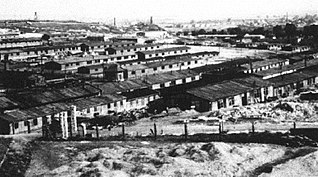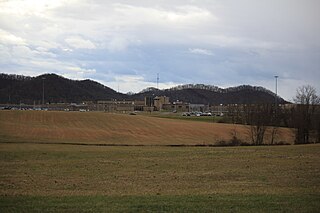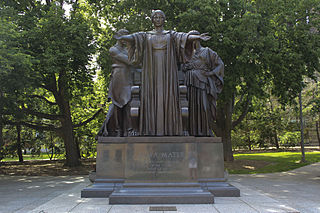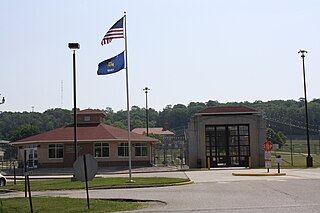
Auschwitz concentration camp was a complex of over 40 concentration and extermination camps operated by Nazi Germany in occupied Poland during World War II and the Holocaust. It consisted of Auschwitz I, the main camp (Stammlager) in Oświęcim; Auschwitz II-Birkenau, a concentration and extermination camp with gas chambers; Auschwitz III-Monowitz, a labor camp for the chemical conglomerate IG Farben; and dozens of subcamps. The camps became a major site of the Nazis' final solution to the Jewish question.
Prison sexuality consists of sexual relationships between prisoners or between a prisoner and a prison employee or other persons to whom prisoners have access. Since prisons are usually separated by sex, most sexual activity is with a same-sex partner. Exceptions to this include sex with spouses/partners during conjugal visits and sex with a prison employee of the opposite sex.

San Quentin State Prison (SQ) is a California Department of Corrections and Rehabilitation state prison for men, located north of San Francisco in the unincorporated place of San Quentin in Marin County.

Płaszów or Kraków-Płaszów was a Nazi concentration camp operated by the SS in Płaszów, a southern suburb of Kraków, in the General Governorate of German-occupied Poland. Most of the prisoners were Polish Jews who were targeted for destruction by Nazi Germany during the Holocaust. Many prisoners died because of executions, forced labor, and the poor conditions in the camp. The camp was evacuated in January 1945, before the Red Army's liberation of the area on 20 January.

Incarceration in the United States is a primary form of punishment and rehabilitation for the commission of felonies and other offenses. As of January 2023, the United States has the sixth highest per-capita incarceration rate in the world, at 505 people per 100,000; and the second largest prison population in the world. In 2018, the United States had the highest incarceration rate in the world with 698 people incarcerated per 100,000, this includes the incarceration rate for adults or people tried as adults. This meant that one out of every 5 people imprisoned across the world in 2018 was incarcerated in the United States. Prison, parole, and probation operations generate an $81 billion annual cost to U.S. taxpayers, with an additional $63 billion for policing. Court costs, bail bond fees, and prison phone fees generate another $38 billion in individual costs annually.

The Federal Prison Camp, Alderson is a minimum-security United States federal prison for female inmates in West Virginia. It is operated by the Federal Bureau of Prisons, a division of the United States Department of Justice.
Prison rape commonly refers to the rape of inmates in prison by other inmates or prison staff. In 2001, Human Rights Watch estimated that at least 4.3 million inmates had been raped while incarcerated in the United States. A United States Department of Justice report, Sexual Victimization in Prisons and Jails Reported by Inmates, states that "In 2011–12, an estimated 4.0% of state and federal prison inmates and 3.2% of jail inmates reported experiencing one or more incidents of sexual victimization by another inmate or facility staff in the past 12 months or since admission to the facility, if less than 12 months." However, advocates dispute the accuracy of the numbers, saying they seem to under-report the real numbers of sexual assaults in prison, especially among juveniles.
The women in prison film is a subgenre of exploitation film that began in the early 20th century and continues to the present day.

The Federal Correctional Institution, Danbury is a low-security United States federal prison for male and female inmates in Danbury, Connecticut. It is operated by the Federal Bureau of Prisons, a division of the United States Department of Justice. The facility also has an adjacent satellite prison camp that houses minimum-security female offenders.

Central California Women's Facility (CCWF) is a female-only California Department of Corrections and Rehabilitation state prison located in Chowchilla, California. It is across the road from Valley State Prison. CCWF is the second largest female correctional facility in the United States, and houses the only State of California death row for women.

Valley State Prison (VSP), previously the Valley State Prison for Women (VSPW), is a state prison in Chowchilla, California. It is across the road from Central California Women's Facility. It was formerly a prison for women.

The Southern Ohio Correctional Facility is a maximum security prison located just outside Lucasville in Scioto County, Ohio. The prison was constructed in 1972. As of 2022, the warden is Donald Redwood.

The Texas Department of Criminal Justice (TDCJ) is a department of the government of the U.S. state of Texas. The TDCJ is responsible for statewide criminal justice for adult offenders, including managing offenders in state prisons, state jails, and private correctional facilities, funding and certain oversight of community supervision, and supervision of offenders released from prison on parole or mandatory supervision. The TDCJ operates the largest prison system in the United States.

Alumni are former students of a school, college, or university who have either attended or graduated in some fashion from the institution. The feminine plural alumnae is sometimes used for groups of women. The word is Latin and means "one who is being nourished". The term is not synonymous with "graduate"; one can be an alumnus without graduating. The term is sometimes used to refer to a former employee or member of an organization, contributor, or inmate.

A prison, also known as a jail, gaol, penitentiary, detention center, correction center, correctional facility, lock-up, hoosegow or remand center, is a facility in which inmates are confined against their will and usually denied a variety of freedoms under the authority of the state as punishment for various crimes. Prisons are most commonly used within a criminal justice system: people charged with crimes may be imprisoned until their trial; those pleading or being found guilty of crimes at trial may be sentenced to a specified period of imprisonment. In simplest terms, a prison can also be described as a building in which people are legally held as a punishment for a crime they have committed.

Taycheedah Correctional Institution is a prison in Fond du Lac, Wisconsin near the Town of Taycheedah. Established in 1921, it was known as Wisconsin Home for Women until 1975. The facility houses maximum-security and medium-security adult females, with an average population of 936 as of May 2019.
Death row, also known as condemned row, is a place in a prison that houses inmates awaiting execution after being convicted of a capital crime and sentenced to death. The term is also used figuratively to describe the state of awaiting execution, even in places where no special facility or separate unit for condemned inmates exists. In the United States, after an individual is found guilty of a capital offense in states where execution is a legal penalty, the judge will give the jury the option of imposing a death sentence or life imprisonment without the possibility of parole. It is then up to the jury to decide whether to give the death sentence; this usually has to be a unanimous decision. If the jury agrees on death, the defendant will remain on death row during appeal and habeas corpus procedures, which may continue for several decades.
The Baldwin State Prison, previously the Baldwin Correctional Institution and the Georgia Women's Correctional Institution (GWCI), is a prison located in Milledgeville, Georgia, United States, with a Hardwick postal address. The prison has a capacity of 900. After complaints in the early 1990s by more than 200 women of sexual abuse by guards, an investigation was conducted. More than a dozen guards were prosecuted. The state decided to move the women to other prison facilities for a total change in culture. This facility now houses only adult male felons, with a capacity of 992.

Ravensbrück was a German concentration camp exclusively for women from 1939 to 1945, located in northern Germany, 90 km (56 mi) north of Berlin at a site near the village of Ravensbrück. The camp memorial's estimated figure of 132,000 women who were in the camp during the war includes about 48,500 from Poland, 28,000 from the Soviet Union, almost 24,000 from Germany and Austria, nearly 8,000 from France, and thousands from other countries including a few from the United Kingdom and the United States. More than 20,000 of the total were Jewish. Eighty-five percent were from other races and cultures. More than 80% were political prisoners. Many prisoners were employed as slave labor by Siemens & Halske. From 1942 to 1945, the Nazis undertook medical experiments to test the effectiveness of sulfonamides.

The incarceration of women in the United States refers to the imprisonment of women in both prisons and jails in the United States. There are approximately 219,000 incarcerated women in the US according to a November 2018 report by the Prison Policy Initiative, and the rate of incarceration of women in the United States is at a historic and global high, with 133 women in correctional facilities per every 100,000 female citizens. The United States is home to just 4% of the world's female population, yet the US is responsible for 33% of the entire world's incarcerated female population. The steep rise in the population of incarcerated women in the US is linked to the complex history of the war on drugs and the US's prison–industrial complex, which lead to mass incarceration among many demographics, but had particularly dramatic impacts on women and especially women of color. However, women made up only 10.4% of the US prison and jail population, as of 2015.